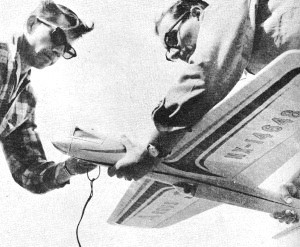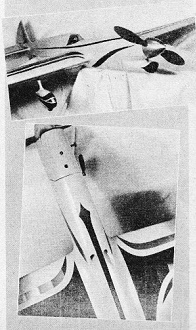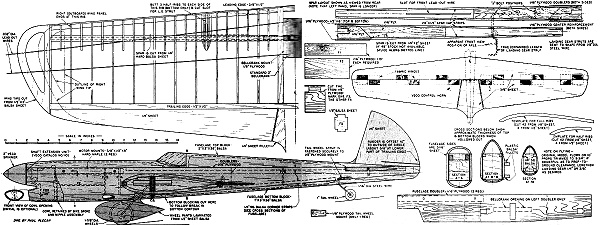|
Website visitor Mark Radcliff
(yes, THE Mark Radcliff, of 75-77-79-81 USA F3a RC Aerobatic
Team fame) wrote to request that I scan the article for Steve Wooley's control
line Argus, which, appeared in the August 1961 American Modeler. The Argus was the
star of the 1960 world championships in Hungary. Note the unique wing construction
where rather than using full ribs, upper and lower outlines are used that sit over
and under the beefy solid wing spar. The entire article is very short.
The ARGUS in Hungary
The Hungarians called this U-control stunt THE MOST BEAUTIFUL PLANE IN
THE WORLD!

Steve Wooley of Marietta, Ohio, with his "Argus" aerobatic craft
at the world championships in Hungary last year. Design has garnered 50 high place
awards including King Orange 1st!

Steve Wooley and Don Still (right) fire up Argus during '60 C/L
Internats. Full size plans are on Hobby Helper Group Plan # 861
From its name to the tip of its tail wheel "Argus" (Greek God of the Sky) represents
the author's concept of a functional design combined with pleasing lines to help
garner those appearance points so important in present-day contest flying. Argus
was acclaimed as the "most beautifully designed and finished" model at the World
Champion-ships in Hungary by participating contestants and all foreign publications.
Argus is a precision aerobatic model that has failed only twice since 1958 to bring
home the hardware. Probably one of the smallest stunt designs flying today, Argus
sports only 500 square inches of wing area and an all-up weight of 39 ounces. So
a Fox 29 has no trouble at all in pulling it around, even in windy weather. A torsion
bar landing gear guarantees perfect landings every time.
Construction is not as simple as a D-tube wing, but once tried, you will probably
not want to use any other method, due to the accurate and fast construction routine.
A word about weight - build your model as light as you can, and don't worry about
it being too light. Some months ago an Argus was finished that tipped the scales
at only 34 ounces. This was one of the models that went to Budapest to participate
in the 1960 International Control Line Meet. Light weight is the secret to good
"stuntability," but a 41 to 43 ounce model will fly quite well, provided it is properly
balanced. Use as light a grade of balsa as you can. I prefer Sig Contest grade,
and with gratifying results.
Begin construction by cutting fuselage sides from 3/16" sheet balsa. Also cut
out 1/16" plywood doublers, including all openings shown on the plan. Accurately!
Assemble the doublers and sides carefully, matching up the edges as best you can.
When the cement is dry, cut through all spar and other wing member openings in the
balsa sheet sides. The 3/8" x 1/2" hard maple motor mounts are cemented and bolted
on. Lay down the fuselage sides for the time being, as the wing must be started
now.

In lower [above] photos note long, clean nose, and low turtle
deck. Wide spread gear assures good ground handling. (R. Moulton pix)
Select light, firm 14"x2"x48" balsa for the spar. If 48" lengths are not available,
a splice as shown on the plan will be necessary. Do the cutting of the tapers as
accurately as you can, as the ribs will not fit too well otherwise. Add the 1/16"
plywood doublers and rein-forcements shown, then allow the cement 24 hours drying
time so that the assembled parts do not slip out of place in later handling. This
is the time for those "simple" parts that still need to be made. The rudder, stab,
elevators and flaps are blanked out, cut and shaped. Sand to a smooth overall finish
to minimize final sanding, when you will be eager to get the paint job done. The
fuselage formers, bellcrank mount and ribs are cut out and stacked for later use.
Bend the landing gear struts as shown; 1/8" steel wire, is needed - be sure that
you bend a left and a right unit so that you won't be stymied later with "two left
feet."
The bellcrank mount is inserted and cemented in the spar center. Be sure the
lead out slot is cut into the spar. If not, do it now, as per the spar plan. Neatly
cement on 1/8"x1/2" hard balsa cap strips (top and bottom), and there is your finished
"I" beam spar.
Additional construction instructions appear on Group Plan #861 from Hobby Helpers.

Argus Plans<click
for larger version>
Notice:
The AMA Plans Service offers a
full-size version of many of the plans show here at a very reasonable cost. They
will scale the plans any size for you. It is always best to buy printed plans because
my scanner versions often have distortions that can cause parts to fit poorly. Purchasing
plans also help to support the operation of the
Academy of Model Aeronautics - the #1
advocate for model aviation throughout the world. If the AMA no longer has this
plan on file, I will be glad to send you my higher resolution version.
Try my Scale Calculator for
Model Airplane Plans.
Here is a photo that Mark Radcliff sent with his e-mail:

Mark Radcliff with Phoenix 8 and Yak 54
Posted February 9, 2011
|